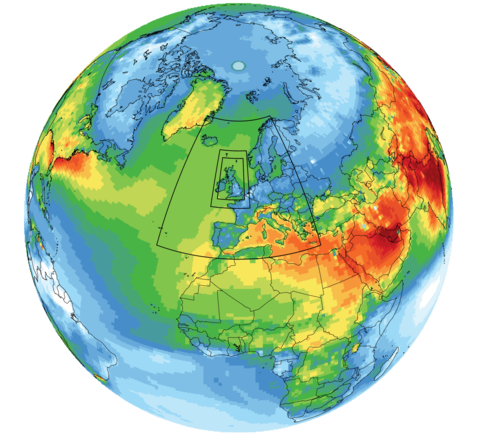The EMEP4UK model framework consists of an atmospheric chemistry transport model (ACTM) which simulates hourly to annual average atmospheric composition and deposition of various pollutants and the weather research and forecast model (WRF - https://www2.mmm.ucar.edu/wrf/users/). Pollutants simulated include PM10, PM2.5, secondary organic aerosols (SOA), elemental carbon (EC), secondary inorganic aerosols (SIA), SO2, NH3, NOx, and O3. Dry and wet deposition of pollutants are also calculated by the model. WRF is used to calculate the required meteorological input data for the ACTM.
EMEP4UK operates at horizontal resolutions ranging from 1.0x1.0 degress for a global domain to ~1km2 for a UK domain in a one-way nesting approach. A typical model domain setup is shown in the image on the right. This model domain setup uses a horizontal resolutions of: 1.0x1.0 degress for the full globe, 0.33x0.33 degrees for a European domain, 0.11x0.11 for the British Isles, and finally a 0.037x0.037 for the UK (~4x4 km2 at the equator) .
The default vertical domain ranges from ~45 m for the first layer near the surface up to ~16 km at the top of the vertical domain at 100hPa.
The default chemical scheme is the EmChem16 as it has be extensively validated at the European scale. It has 72 species and 137 reactions. Details of this scheme and the others available can be found in the publication Simpson et al. 2012.
Two types of emissions are present in the model: anthropogenic and natural. Anthropogenic emissions of NOx, NH3, SO2, primary PM2.5, primary PMcoarse (the difference between PM10 and PM2.5), CO, and non-methane volatile organic compounds (NMVOC) are included from different sources at respective spatial resolutions. For the UK, emissions values are taken from the National Atmospheric Emission Inventory (NAEI ) at 1 km2 resolution. For the rest of the European domain, the model emission estimates are provided by the EMEP Centre for Emission Inventories and Projections (CEIP ).
